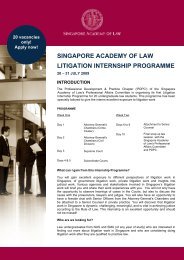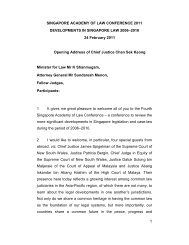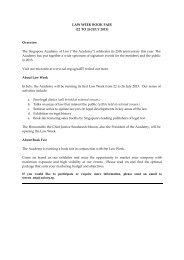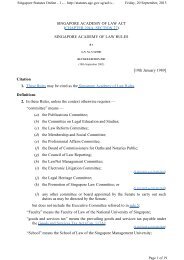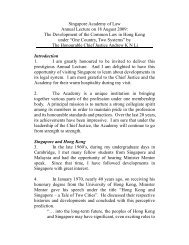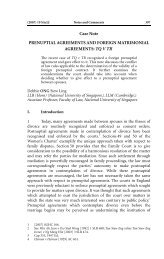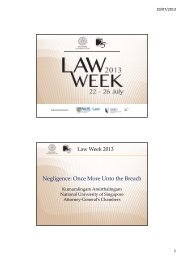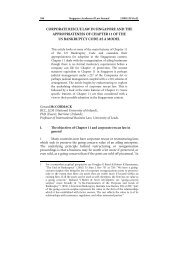2. Managing Mens Rea in Singapore - Singapore Academy of Law
2. Managing Mens Rea in Singapore - Singapore Academy of Law
2. Managing Mens Rea in Singapore - Singapore Academy of Law
You also want an ePaper? Increase the reach of your titles
YUMPU automatically turns print PDFs into web optimized ePapers that Google loves.
318S<strong>in</strong>gapore <strong>Academy</strong> <strong>of</strong> <strong>Law</strong> Journal (2006)knowledge that death was likely – death is normally the result <strong>of</strong> serious<strong>in</strong>juries and it is not an unfair assumption that most people must knowwhat serious <strong>in</strong>juries are and that they are likely to cause death. Yet thecrim<strong>in</strong>al law should not be based entirely on what is normally the case orwhat most people must know – death sometimes occurs from <strong>in</strong>jurieswhich are not normally thought <strong>of</strong> as serious, and many people do notknow this. A stab to the heart, adm<strong>in</strong>istered with significant force willnormally satisfy either requirement, unless the accused is able to showthat it was accidental, <strong>in</strong> the sense that the accused <strong>in</strong>tended no <strong>in</strong>jury atall or that another non-fatal <strong>in</strong>jury was <strong>in</strong>tended. But what does one dowith an accused who presses a pillow onto the face <strong>of</strong> a victim <strong>in</strong> order tosilence and not to kill, or an accused who slashes the leg <strong>of</strong> a victim <strong>in</strong>order to prevent escape and not to kill? Section 300(c) has the potential tomake these situations murder and punishable with death, and it is <strong>in</strong>cases like these that s 300(c) is subjected to the greatest stress.8 To the credit <strong>of</strong> our judges, they have extended a lifel<strong>in</strong>e <strong>in</strong> aremarkable series <strong>of</strong> cases. This the courts achieved through the device <strong>of</strong>subtle dist<strong>in</strong>ctions between the <strong>in</strong>jury <strong>in</strong>tended and the <strong>in</strong>jury whichf<strong>in</strong>ally caused death. Embedded <strong>in</strong> s 300(c) is an <strong>in</strong>herent ambiguity: it ismurder only if the <strong>in</strong>jury <strong>in</strong>tended was the same as the fatal <strong>in</strong>jury. Thisuncerta<strong>in</strong>ty was anticipated <strong>in</strong> Virsa S<strong>in</strong>gh: 11In consider<strong>in</strong>g whether the <strong>in</strong>tention was to <strong>in</strong>flict the <strong>in</strong>jury found tohave been <strong>in</strong>flicted, the enquiry necessarily proceeds on broad l<strong>in</strong>es as,for example, whether there was an <strong>in</strong>tention to strike at a vital or adangerous spot, and whether with sufficient force to cause the k<strong>in</strong>d <strong>of</strong><strong>in</strong>jury found to have been <strong>in</strong>flicted. It is, <strong>of</strong> course, not necessary toenquire <strong>in</strong>to every last detail as, for <strong>in</strong>stance, whether the prisoner<strong>in</strong>tended to have the bowels fall out, or whether he <strong>in</strong>tended topenetrate the liver or the kidneys or the heart. Otherwise, a man whohas no knowledge <strong>of</strong> anatomy could never be convicted, for, if he doesnot know that there is a heart or a kidney or bowels, be cannot be saidto have <strong>in</strong>tended to <strong>in</strong>jure them. Of course, that is not the k<strong>in</strong>d <strong>of</strong>enquiry. It is broad based and simple and based on common sense: thek<strong>in</strong>d <strong>of</strong> enquiry that "twelve good men and true” could readilyappreciate and understand.9 The problem with this k<strong>in</strong>d <strong>of</strong> <strong>in</strong>struction is that it does not tellus exactly how particular the <strong>in</strong>tention must be. It is <strong>of</strong>ten that <strong>in</strong>juryleads to death <strong>in</strong> a cha<strong>in</strong> <strong>of</strong> events – <strong>in</strong>cision, severance <strong>of</strong> artery, loss <strong>of</strong>blood, death. Although it seems clear that death need not be11 Supra n 9, at 467.



